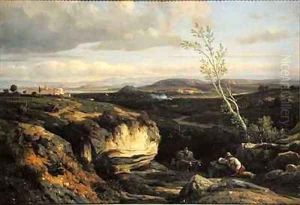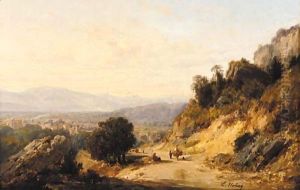Francois-Antoine-Leon Fleury Paintings
François-Antoine-Léon Fleury was a notable French painter born in 1804 in Paris, France. Fleury's artistic journey began under the guidance of his father, François Fleury-Richard, and later, he furthered his education under the tutelage of Jean-Victor Bertin, who was a prominent landscape painter of his time. This education grounded Fleury in the classical traditions of landscape painting, which significantly influenced his later work. Fleury's style was deeply rooted in the Romantic movement, characterized by its emphasis on emotion and the sublime beauty of nature. His landscapes often depicted historical or mythological scenes, imbued with a sense of drama and emotional depth that was characteristic of Romanticism. Despite the popularity of Romanticism during his lifetime, Fleury also exhibited a keen interest in the emerging Realist movement, which sought to depict subjects in a more truthful, unidealized manner. This duality of influence is evident in the nuanced execution of his landscapes, which balance romanticized visions of nature with a meticulous attention to detail. Throughout his career, Fleury's works were well-received, and he regularly participated in the Paris Salon, the official art exhibition of the Académie des Beaux-Arts in Paris. His contributions to French art were recognized by his contemporaries, and his paintings continue to be appreciated for their contribution to the Romantic and early Realist movements in France. Fleury's legacy is also preserved through his influence on his students and the younger generation of painters who looked up to him as a bridge between Romanticism and Realism. François-Antoine-Léon Fleury passed away in 1858, leaving behind a body of work that continues to be celebrated for its beauty, emotional depth, and historical significance.


